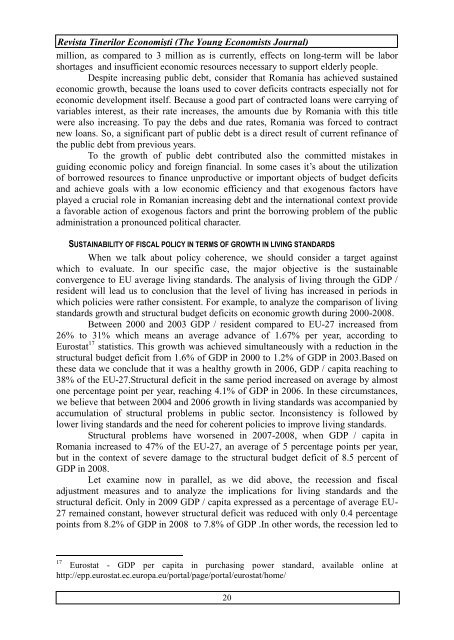View - Centru E-learning de Instruire al Resurselor Umane din ...
View - Centru E-learning de Instruire al Resurselor Umane din ...
View - Centru E-learning de Instruire al Resurselor Umane din ...
You also want an ePaper? Increase the reach of your titles
YUMPU automatically turns print PDFs into web optimized ePapers that Google loves.
Revista Tinerilor Economişti (The Young Economists Journ<strong>al</strong>)million, as compared to 3 million as is currently, effects on long-term will be laborshortages and insufficient economic resources necessary to support el<strong>de</strong>rly people.Despite increasing public <strong>de</strong>bt, consi<strong>de</strong>r that Romania has achieved sustaine<strong>de</strong>conomic growth, because the loans used to cover <strong>de</strong>ficits contracts especi<strong>al</strong>ly not foreconomic <strong>de</strong>velopment itself. Because a good part of contracted loans were carrying ofvariables interest, as their rate increases, the amounts due by Romania with this titlewere <strong>al</strong>so increasing. To pay the <strong>de</strong>bs and due rates, Romania was forced to contractnew loans. So, a significant part of public <strong>de</strong>bt is a direct result of current refinance ofthe public <strong>de</strong>bt from previous years.To the growth of public <strong>de</strong>bt contributed <strong>al</strong>so the committed mistakes ingui<strong>din</strong>g economic policy and foreign financi<strong>al</strong>. In some cases it’s about the utilizationof borrowed resources to finance unproductive or important objects of budget <strong>de</strong>ficitsand achieve go<strong>al</strong>s with a low economic efficiency and that exogenous factors haveplayed a cruci<strong>al</strong> role in Romanian increasing <strong>de</strong>bt and the internation<strong>al</strong> context provi<strong>de</strong>a favorable action of exogenous factors and print the borrowing problem of the publicadministration a pronounced politic<strong>al</strong> character.SUSTAINABILITY OF FISCAL POLICY IN TERMS OF GROWTH IN LIVING STANDARDSWhen we t<strong>al</strong>k about policy coherence, we should consi<strong>de</strong>r a target againstwhich to ev<strong>al</strong>uate. In our specific case, the major objective is the sustainableconvergence to EU average living standards. The an<strong>al</strong>ysis of living through the GDP /resi<strong>de</strong>nt will lead us to conclusion that the level of living has increased in periods inwhich policies were rather consistent. For example, to an<strong>al</strong>yze the comparison of livingstandards growth and structur<strong>al</strong> budget <strong>de</strong>ficits on economic growth during 2000-2008.Between 2000 and 2003 GDP / resi<strong>de</strong>nt compared to EU-27 increased from26% to 31% which means an average advance of 1.67% per year, accor<strong>din</strong>g toEurostat 17 statistics. This growth was achieved simultaneously with a reduction in thestructur<strong>al</strong> budget <strong>de</strong>ficit from 1.6% of GDP in 2000 to 1.2% of GDP in 2003.Based onthese data we conclu<strong>de</strong> that it was a he<strong>al</strong>thy growth in 2006, GDP / capita reaching to38% of the EU-27.Structur<strong>al</strong> <strong>de</strong>ficit in the same period increased on average by <strong>al</strong>mostone percentage point per year, reaching 4.1% of GDP in 2006. In these circumstances,we believe that between 2004 and 2006 growth in living standards was accompanied byaccumulation of structur<strong>al</strong> problems in public sector. Inconsistency is followed bylower living standards and the need for coherent policies to improve living standards.Structur<strong>al</strong> problems have worsened in 2007-2008, when GDP / capita inRomania increased to 47% of the EU-27, an average of 5 percentage points per year,but in the context of severe damage to the structur<strong>al</strong> budget <strong>de</strong>ficit of 8.5 percent ofGDP in 2008.Let examine now in par<strong>al</strong>lel, as we did above, the recession and fisc<strong>al</strong>adjustment measures and to an<strong>al</strong>yze the implications for living standards and thestructur<strong>al</strong> <strong>de</strong>ficit. Only in 2009 GDP / capita expressed as a percentage of average EU-27 remained constant, however structur<strong>al</strong> <strong>de</strong>ficit was reduced with only 0.4 percentagepoints from 8.2% of GDP in 2008 to 7.8% of GDP .In other words, the recession led to17Eurostat - GDP per capita in purchasing power standard, available online athttp://epp.eurostat.ec.europa.eu/port<strong>al</strong>/page/port<strong>al</strong>/eurostat/home/20















